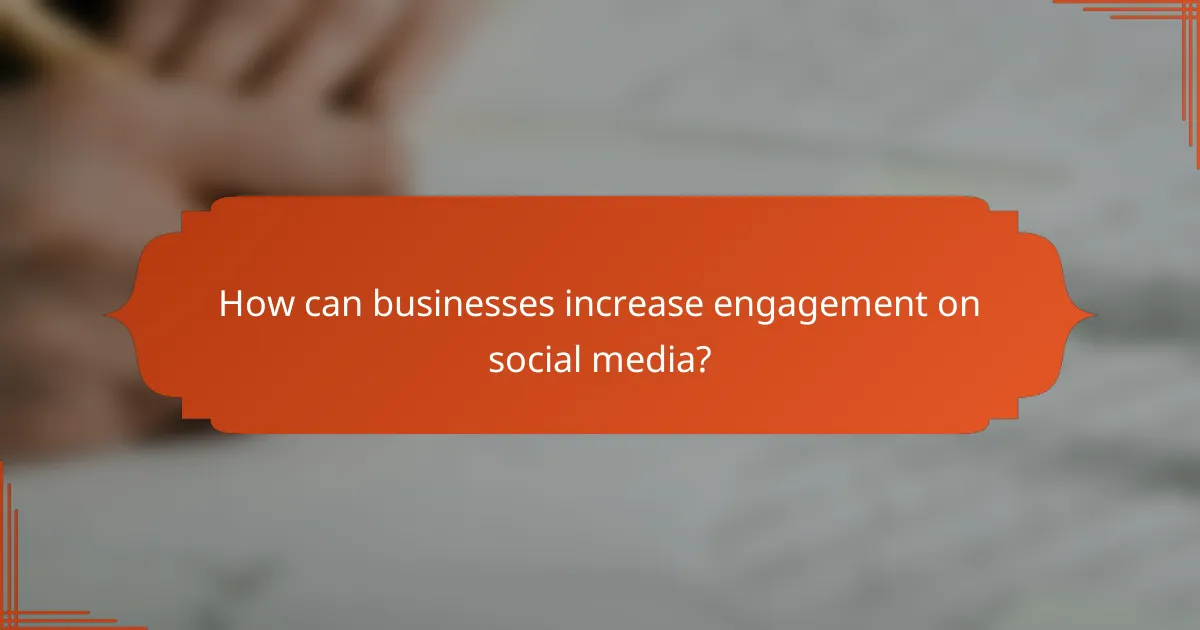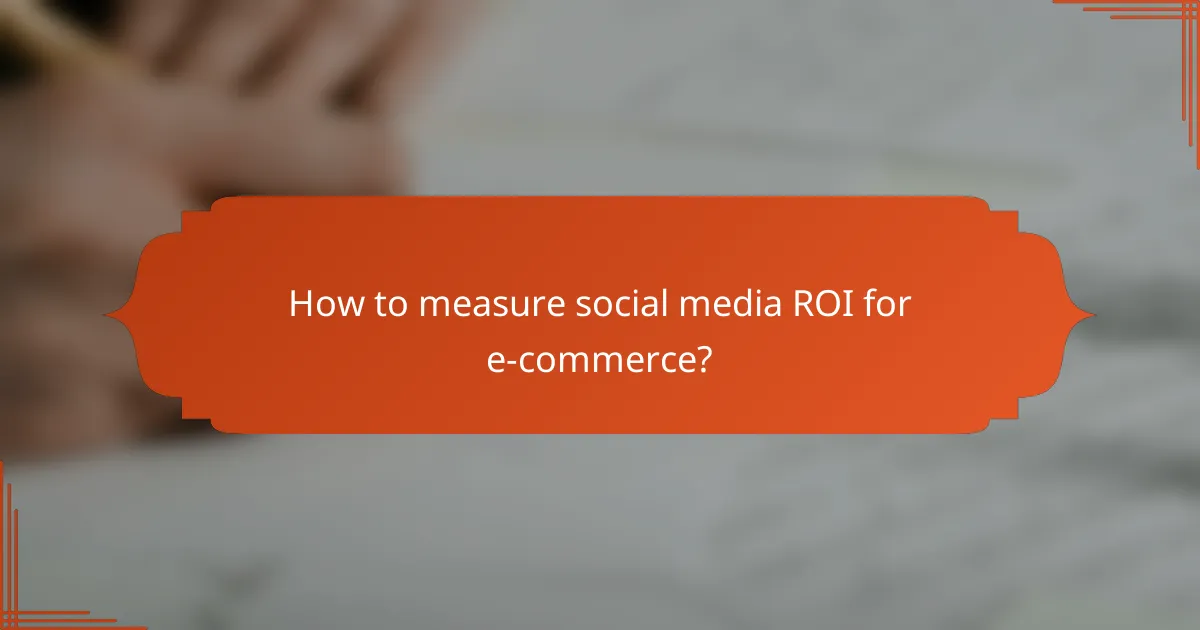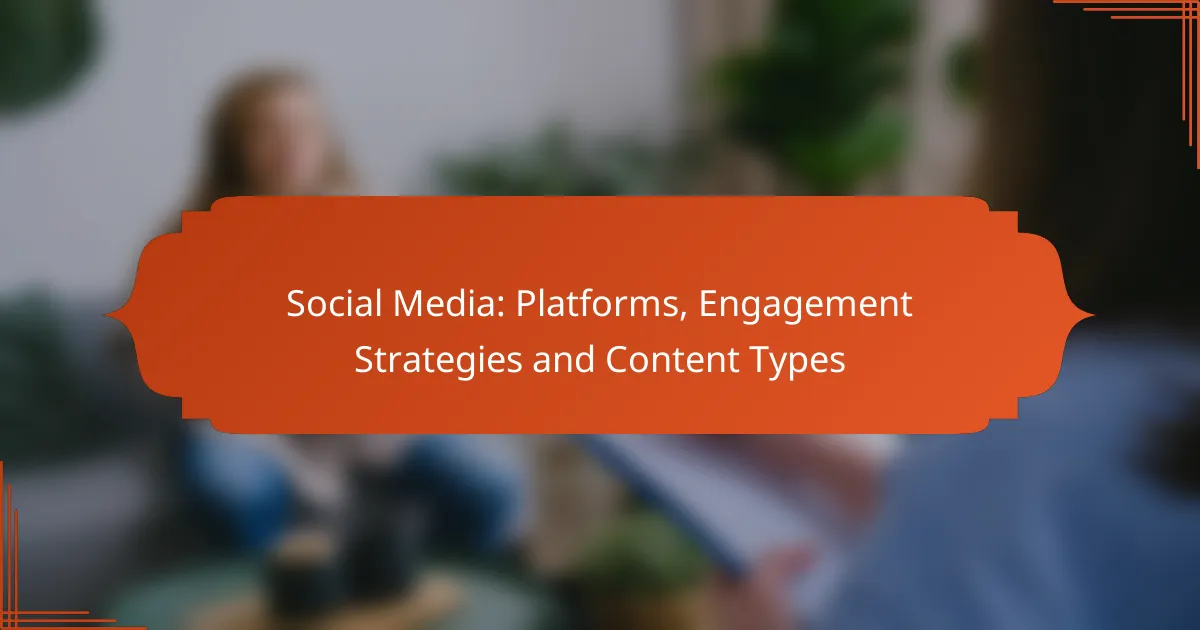Social media has become an essential tool for businesses, particularly in e-commerce, where platforms like Facebook, Instagram, and Pinterest offer unique engagement strategies. By creating interactive and visually appealing content, companies can foster audience participation and enhance their online presence. Effective engagement techniques, such as user-generated content and live events, further amplify interaction rates and drive sales.

Which social media platforms are most effective for e-commerce?
Effective social media platforms for e-commerce include Facebook, Instagram, Pinterest, Twitter, and LinkedIn. Each platform offers unique tools and audience engagement strategies that can significantly enhance online sales.
Facebook for targeted advertising
Facebook is a powerful tool for targeted advertising, allowing businesses to reach specific demographics based on interests, behaviors, and location. Advertisers can create customized ads that appear in users’ feeds, increasing the likelihood of engagement and conversion.
Utilizing Facebook’s Ad Manager, businesses can set budgets and track performance metrics to optimize their campaigns. A/B testing different ad formats can help identify which resonates best with the target audience.
Instagram for visual engagement
Instagram excels in visual engagement, making it ideal for brands with strong imagery or lifestyle products. The platform’s focus on photos and videos allows businesses to showcase their products in creative ways, attracting potential customers through eye-catching content.
Utilizing features like Stories, Reels, and shoppable posts can enhance product visibility. Brands should aim for high-quality visuals and consistent branding to build a recognizable presence on Instagram.
Pinterest for product discovery
Pinterest serves as a visual discovery platform where users seek inspiration for purchases. This makes it particularly effective for e-commerce, as users often browse with the intent to buy. Businesses can create Pins that link directly to product pages, facilitating easy shopping.
To maximize reach, brands should focus on creating engaging, high-quality Pins and utilize keywords effectively in descriptions. Regularly updating boards with seasonal or trending content can keep the audience engaged.
Twitter for customer service
Twitter is an effective platform for customer service, allowing brands to interact with customers in real-time. Quick responses to inquiries or complaints can enhance customer satisfaction and build brand loyalty.
Businesses should monitor mentions and hashtags related to their brand to address customer concerns promptly. Establishing a dedicated support account can streamline communication and improve response times.
LinkedIn for B2B marketing
LinkedIn is the go-to platform for B2B marketing, connecting businesses with professionals and decision-makers. Companies can share industry insights, case studies, and product information to establish authority and attract leads.
Utilizing LinkedIn’s advertising options, such as sponsored content and InMail, can help target specific industries or job titles. Networking through groups and engaging with relevant content can further enhance visibility and credibility in the B2B space.

How can businesses increase engagement on social media?
Businesses can increase engagement on social media by creating content that encourages interaction and participation from their audience. This can be achieved through various strategies, including utilizing interactive content, implementing user-generated content, hosting live events, and creating polls and surveys.
Utilizing interactive content
Interactive content, such as quizzes, games, and infographics, can significantly boost user engagement. By encouraging users to participate actively, businesses can create a more immersive experience that keeps audiences interested. For example, a fashion brand might create a quiz to help users find their style, leading to increased shares and comments.
When implementing interactive content, ensure it aligns with your brand and resonates with your target audience. Monitor engagement metrics to understand what types of content perform best and adjust your strategy accordingly.
Implementing user-generated content
User-generated content (UGC) involves sharing content created by customers, such as reviews, photos, or videos. This not only fosters community but also builds trust, as potential customers often value peer recommendations. For instance, a restaurant might encourage diners to post their meals on social media, showcasing real experiences.
To effectively implement UGC, create a branded hashtag and encourage users to tag your business. Regularly feature UGC on your channels to acknowledge contributors and inspire others to participate.
Hosting live events and Q&A sessions
Live events and Q&A sessions allow businesses to engage directly with their audience in real-time. This format can humanize your brand and provide valuable insights, as customers can ask questions and receive immediate responses. For example, a tech company might host a live demo of a new product, allowing viewers to ask questions as they watch.
Promote these events in advance to maximize attendance and consider recording sessions for later viewing. Engaging with comments during the event can further enhance the experience and encourage ongoing dialogue.
Creating polls and surveys
Polls and surveys are effective tools for gathering feedback and opinions from your audience. They can help businesses understand customer preferences and improve products or services. For example, a coffee shop might run a poll asking customers to vote on their favorite seasonal drink.
Keep polls and surveys short and straightforward to encourage participation. Share results with your audience to show that their input is valued and to foster a sense of community around your brand.

What types of content work best on social media?
Engaging content on social media typically includes visually appealing images and videos, informative articles, and concise formats like reels. These types resonate well with audiences, driving higher engagement and interaction rates.
High-quality images and videos
High-quality images and videos capture attention quickly and are essential for effective social media engagement. Visual content should be well-composed, properly lit, and relevant to your audience’s interests. Aim for a mix of professional and authentic visuals to maintain relatability.
Consider using tools like Canva or Adobe Spark to create visually appealing graphics. Regularly posting high-quality content can significantly enhance your brand’s visibility and encourage shares, which expands your reach.
Informative blog posts and articles
Informative blog posts and articles provide depth and value, establishing your authority in a specific niche. These pieces should be concise, engaging, and tailored to your audience’s needs, ideally between 800 and 1,500 words for optimal readability.
Linking to your blog posts on social media can drive traffic to your website. Use compelling headlines and snippets to entice users to click through, and consider including visuals to break up text and enhance engagement.
Short-form videos and reels
Short-form videos and reels are increasingly popular on platforms like Instagram and TikTok, allowing brands to convey messages quickly and creatively. These videos should be entertaining or informative, typically lasting between 15 to 60 seconds.
Focus on storytelling and authenticity to connect with viewers. Use trending sounds or challenges to increase visibility, and include captions to ensure your message is accessible even without sound.
Infographics for quick insights
Infographics are effective for presenting complex information in a visually digestible format. They combine graphics with concise text to convey key insights quickly, making them ideal for sharing on social media platforms.
When creating infographics, ensure they are visually appealing and easy to understand. Use clear headings, bullet points, and relevant data to enhance clarity. Infographics can encourage shares and save time for your audience, making them a valuable addition to your content strategy.

What are the best practices for social media marketing?
The best practices for social media marketing involve a combination of strategic planning, consistent engagement, and data-driven adjustments. By following these guidelines, businesses can enhance their online presence and foster stronger connections with their audience.
Consistent posting schedule
Maintaining a consistent posting schedule is crucial for keeping your audience engaged and informed. Aim to post regularly, whether it’s daily, a few times a week, or weekly, depending on your audience’s preferences and platform norms.
Utilize tools like social media calendars to plan your content in advance. This helps ensure that you cover a variety of topics and formats, such as images, videos, and articles, while avoiding gaps in your posting frequency.
Engaging with followers promptly
Prompt engagement with followers can significantly enhance your brand’s reputation and build loyalty. Respond to comments and messages quickly, ideally within a few hours, to show that you value their input and are attentive to their needs.
Encourage conversations by asking questions and inviting feedback in your posts. This not only boosts engagement but also provides insights into your audience’s preferences and interests.
Using analytics for strategy adjustment
Leveraging analytics is essential for refining your social media marketing strategy. Regularly review metrics such as engagement rates, reach, and conversion rates to identify what content resonates best with your audience.
Use these insights to adjust your posting frequency, content types, and engagement tactics. For example, if video posts perform significantly better than images, consider increasing your video content to maximize audience interaction.

How to measure social media ROI for e-commerce?
Measuring social media ROI for e-commerce involves evaluating the revenue generated from social media efforts against the costs incurred. Key metrics include conversion rates, engagement metrics, and customer acquisition costs, which together provide a comprehensive view of social media effectiveness.
Tracking conversion rates
Tracking conversion rates is essential for understanding how social media influences sales. This metric indicates the percentage of users who complete a desired action, such as making a purchase after clicking on a social media post. To calculate it, divide the number of conversions by the total number of visitors from social media, then multiply by 100.
For example, if 200 users visited your site from social media and 20 made a purchase, your conversion rate would be 10%. Regularly monitoring this rate helps identify which platforms and campaigns are most effective.
Analyzing engagement metrics
Engagement metrics, such as likes, shares, comments, and click-through rates, provide insight into how users interact with your content. High engagement often correlates with increased brand awareness and can lead to higher conversion rates. Tools like Google Analytics and social media insights can help track these metrics.
Consider setting benchmarks for engagement based on industry standards. For instance, a typical engagement rate for e-commerce brands might range from 1% to 3%. Regularly analyzing these metrics allows for timely adjustments to content strategies.
Calculating customer acquisition cost
Customer acquisition cost (CAC) measures the total cost of acquiring a new customer through social media. To calculate CAC, divide the total marketing expenses by the number of new customers gained during a specific period. This includes costs like advertising spend, content creation, and any tools used.
For example, if you spent $1,000 on social media marketing and acquired 50 new customers, your CAC would be $20. Keeping CAC low is crucial for profitability, and comparing it to the lifetime value of a customer can help assess overall effectiveness.
